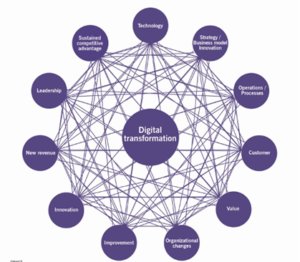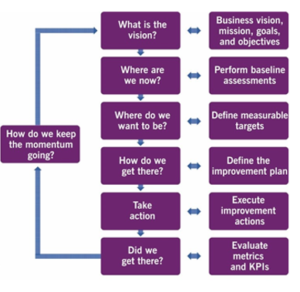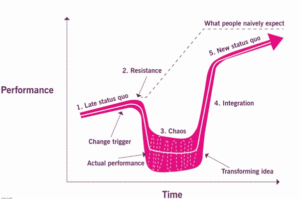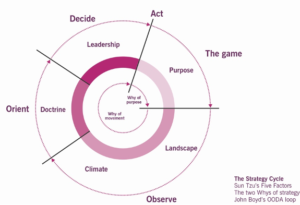ITIL 4: Digital and IT Strategy, or DITS for short, is the last book to be released in a series of five books, each with a different set of global authors. This blog provides an overview of frequently asked questions on the DITS book, including why it’s an essential read for digital leaders, and a summary of some of my favourite topics.
WHY SHOULD YOU CARE ABOUT THE DITS BOOK?
Every organisation must continue to remain relevant in these fast-moving, uncertain, complex, and volatile times we’re living in. Digital transformation and evolution are even more vital to an organisation’s survival now that, with COVID, customers are placing more of an emphasis on digital products and services that are affordable, quick to implement, cloud-based, and dependable.
This book answers some key questions like:
- How do we develop a digital strategy to avoid becoming obsolete?
- How do we leverage technology to radically change the customer experience?
- How do we know if we should invest in a new technology or if it’s just a fad?
The DITS book, written specifically for digital leaders, provides insight into what the best digital organisations get right as well as the pitfalls to avoid when approaching a digital transformation.
Regardless of your role within the business, there are lots of ideas, tools, and techniques contained within the DITS book that will help you, your team, and your organisation improve the way products and services are designed, developed and delivered.
HOW IS THE DITS BOOK STRUCTURED?
The book is broken up into three parts.
Part I of the book offers an overview of fundamental digital strategy concepts and provides clarity around terms such as digitisation and digital transformation, defined here:
Digital Transformation: the use of digital technology to enable a significant improvement in the realisation of the organisation’s objectives that could not feasibly have been achieved by non-digital means.
One of the things I really like about the book is that it clarifies what is meant by the term “digital transformation” as different people often tend to look at these words differently. In fact, it is often much bigger and impacts more areas of our organisation than we may think.
If done well, a digital transformation impacts not only how we work but how we lead, how our organisation is structured, and how we serve our customers (as shown below).

Digital Transformation Components
Part II organises topics according to the Continual Improvement Model. This starts with “What is the vision?” and provides lots of templates, tools, and techniques that can help an organisation in any phase of its digital transformation journey (more on that later).

7-Step Continual Improvement Model
Part III covers key capabilities of a digital organisation, including the characteristics of effective digital leaders, ways to foster an innovative, agile, and resilient culture, how to assess whether emerging technologies are relevant to our organisation, and ways to better understand, analyse, and manage digital risks at a strategic level.
WHAT TOPICS ARE COVERED IN THE DITS BOOK?
The digital strategy concepts in the DITS book come from extensive industry research and interviews with digital leaders across a diverse range of organisations. As a result, several concepts are completely new to the ITIL library.
Here are five of my favourite topics along with the book chapter in which they’re covered:
- Crafting a c0mpelling a digital vision (chapter 3). This is a critical starting point for any organisational transformation, digital or otherwise. Unfortunately, it is also one of the most underutilised and overlooked keys to our success. As leaders, we don’t often take the time to create a compelling digital vision, resulting in a transformation effort that isn’t as successful as we had hoped. It often feels like an unnecessary step, and yet changing how our organisation fundamentally works requires a dramatic shift in our teams’ behaviours; and to do that, everyone must understand and embrace the urgency of change. A simple, clear and concrete statement on the ‘why’ and the ‘why we need to do it now’ can serve as a North Star in our transformation efforts and makes the rest of the journey easier. Further, if we can we pair our digital vision with an equally impactful visual picture to supplement our words, it gives us a way to plainly and rapidly explain the vision; and it gives our teams a better way to remember it (pictures being worth 1,000 words and all).
- Implementing large-scale and incremental digital transformations (chapter 6). This chapter gives guidance on how leaders take their strategy and begin to execute a digital transformation. The book outlines different options and challenges, along with the hazards to avoid with each approach. One of the concepts that I’m glad made it into the book is that of the Satir Change Model (pictured below), which shows the path that organisations go through when implementing major change. It’s helpful to understand that the way we anticipate change will happen is a very different thing from how change actually happens. As a result, we leaders must prepare ourselves and our teams for the resulting chaos, resistance, and inevitable failures along the way. In fact, teams will actually become slower before they become faster when forming new habits and doing work they’ve never done before; and we need to be ready to address it and help our teams through it. Change is not for the faint of heart, but the fight, if we stick with it, will be worthwhile.

Satir Change Model
- Parallel operating models (chapter 8). This chapter addresses the question of how leaders on the path to launching a digital business simultaneously manage these two different business models without putting themselves out of business. Essentially, we are trying to change the engines while still flying the plane. It also talks about the fascinating concepts of cannibalism, erosion, concurrence, and synergism and uses industry examples like the New York Times, Apple, and Netflix to explain each approach.
- Characteristics of an effective digital leader (chapter 9). To me, this chapter is really exciting as it comes from our interactions, observations, and research on digital leaders and discusses the characteristics and skills they exhibit. Some of these traits include things like having a ‘digital mindset’, putting a focus on training and education (for ourselves, our peers, and others within our organisation), and taking the time to build trust through relationships. Even when we’re dealing with digital technology, our work as leaders is deeply human. The good news is that these are skills that any of us can practise and develop – ultimately improving ourselves, our teams, and our organisations.
- Fostering an innovative culture (chapter 10). We wrote this chapter to clarify what innovation is (and is not), why it’s vital to the long-term success of an organisation, and how to create an environment that fosters and supports the development, vetting, and launch of innovative products and services.There are some interesting approaches included in the DITS book, including crowdsourced innovation and continuous learning. Check out this article on digital innovation for more detail on this topic.
There are other great tools and techniques in the DITS book that can help us re-imagine, plan, and execute our digital strategy, including Wardley Maps (pictured below), which help us gain ‘situational awareness’ of our current position and inform our strategic direction, Business Model Canvases, the Cynefin framework (which gives decision-making guidance across a variety of situations), and Objectives and Key Results or OKRs (which help us quickly define our organisation’s goals and measure our teams’ results against it).

Wardley Map Strategy Cycle
WHO SHOULD READ THE DITS BOOK?
The DITS book was written for digital and IT leaders – CxOs, heads of service management, senior managers and others – as well as those who are aspiring to lead and want to be able to have more meaningful conversations with their teams, peers, and customers. You can pick up your copy of ITIL 4: Digital and IT Strategy from the itSMF UK bookstore today (with a special 20% discount for members).
WEBINAR
Join me on 14 January 2021 where I’ll be presenting a ‘Getting started with ITIL 4 Digital & IT Strategy‘ webinar for itSMF UK members – register today!

Erika Flora
Erika started her career as a Microbiologist turned Program Manager and discovered a passion for improving how organisations manage the flow of work, deliver great products and services, and better serve their customers. In 2006, she founded BEYOND20, a Digital Transformation consulting and training firm based on ITIL, DevOps, Agile, Lean, and other “best practice” frameworks.
Erika works with leaders in global organisations as a Digital Strategy facilitator and coach. Over the years, she has led several successful technology implementation initiatives and has helped organisations find more success with their Digital Transformation efforts. Erika is an avid blogger, speaker, and advocate of expanding opportunities for women and minorities in technology. Erika calls Washington, DC home; and when not at work, you may find her reading, sailing, or performing improv comedy.


